London's Pride
The Hurlingham Club is an exclusive private members club in Fulham, South West London. It is situated on the banks of the River Thames between Putney and Wandsworth bridges and is only a ten-minute car journey from the heart of the West End.
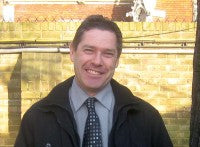
And yet, once inside the forty-two acres of beautiful grounds and gardens, it is hard to imagine that you are anywhere near the heart of one of the biggest and busiest cities in the world.
The club has a membership of over 14,000 and a waiting list longer than the Thames. It boasts some of the finest indoor facilities with a 30 metre indoor heated pool, jacuzzi, dance studio, treatment rooms, squash courts and a brand new state-of-the-art gymnasium.
There is also a 30 metre heated outdoor pool, open during the summer months. Indoor banqueting facilities have recently been improved spectacularly with the addition of a brand new building building capable of staging functions for up to eight hundred seated and 1100 standing people.
This building has a specially commissioned glass dome which is a replica of one destroyed in the Second World War. It was designed in Switzerland and is large enough to accommodate eight full size palm trees which give a wonderful tropical feel, especially in the cold and frost of early January!
The club also has a superb a-la-carte fine dining room, two self-service brasseries, several traditionally decorated 'quiet' rooms for reading and a conservatory, which contains a variety of plants and shrubs, all of which are maintained by the gardening team.
Despite all these fantastic indoor facilities, the jewel in the crown of the Hurlingham Club has always been the extensive grounds with its sports facilities and gardens.
The club has been in existence since 1869 and little has changed since its inception. The grounds provide a living landscape to be enjoyed by the members with the emphasis on providing something for everyone.
There are formal and non-formal planted areas providing a colourful display of annual, biannual and perennial plants. Numerous ornamental lawn areas, all of which have to be presented to a very high standard, are looked over by an impressive variety of trees, with a row of magnificent London planes taking pride of place at the front of the grandiose clubhouse.
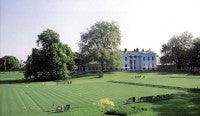
The outdoor grass sports facilities comprise thirty tennis courts, ten full size croquet lawns, two bowling greens and a cricket ground with a twelve-pitch square. In addition, there are twenty-two artificial tennis courts including three acrylic covered courts under the tennis dome, and a winter 9 hole par 3 pitch and putt golf course.
Although the sports surfaces are a very important part of the grounds, the incredible, and ever increasing variety of plants, shrubs and trees that make up the gardens are given equal billing.
Responsible for looking after these superb facilities is Grounds Manager Peter Craig who, last November, celebrated ten years in the post.
"It is amazing how time goes by so quickly and things change" said Peter. "There have been some notable improvements to the grounds during my time here. The new £25 million building extension was one of the first major developments to be completed back in 2004." 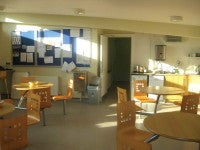
"A recent, and welcome, addition has been our new grounds storage and workshop facility. This has been a £1 million investment that comprises new storage sheds, garages, a mechanics workshop, mess room, offices, chemical storage and equipment wash down facilities. These modern additions have certainly improved working conditions and also helped to improve efficiency. They also highlight the importance of our environmental policy, especially important being so close to the centre of London."
Peter employs fourteen full time staff, split equally between groundsmen and gardeners. In addition six seasonal groundsworkers are employed between March and November along with four attendants whose duties are to keep the paths, roads and patios clean and tidy and ensure that litter bins are regularly emptied.
The garden team is led by Head Gardener, Mike Batie. He has been at the club for twenty-two years and, within the team, is his wife Helen. Peter's right and left hand man is Deputy Grounds Manager, Neil Harvey.

"Neil, Mike and I are very keen on recycling" said Peter. "Previously, it had been costing the club around £10,000 a year in tipping costs. So, we have now invested that money back into developing a compost corner where we can break down leaves, grass cuttings and other natural vegetation. The net result is our own compost for mulching, shrubs and flowerbeds."
"I'm considering employing an additional member of staff to manage this facility, probably part time, with the aim of improving the quality of the compost."
None of the thirty grass tennis courts or the ten croquet lawns were originally constructed for their current levels of usage. They were all areas of what, one hundred years ago, were riverside fields that had been levelled and 'converted' into sports surfaces.
The two bowling greens were purpose built although, like all the other surfaces, there's no drainage systems installed. This rarely presents a problem as the indigenous soil is an extremely free draining dark sandy loam, sitting on top of an equally free draining sandy gravel.
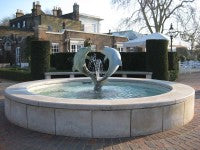 "To improve the binding qualities of the grass court soils we have implemented a hollow coring programme to integrate new loam into the courts, introducing a 12% clay content loam" said Peter.
"To improve the binding qualities of the grass court soils we have implemented a hollow coring programme to integrate new loam into the courts, introducing a 12% clay content loam" said Peter.
"The indigenous clay content is under 6% but we have now raised that to around 12-14%. This has improved the playing quality without reducing the after-rain playability, which is important, as we do not cover them during wet weather."
"We buy the tennis loam from Surrey Loams and the sand (CH45) from Ruffords, it being exactly the same sand as in our previously used topdressing, but without the loam content."
The most serious problem Peter inherited was a layer of thatch on the grass courts which was up to 25mm deep in places! Whilst a vigorous scarification programme, using Huxley tractor mounted scarifiers, made some impression it was clear that more dramatic action was needed to eliminate it.
"We embarked on a programme, not of thatch reduction, but of thatch elimination using a Koro Field Topmaker. With regular in season thatch control and end of season thatch removal we have changed the courts from spongy, slow and low to firm and fast. This programme has certainly improved the performance of the courts."
 "We are now intending to use the Koro to reinstate levels on the courts, again organising a rolling programme of refurbishment with the aim of completing a couple of courts per year."
"We are now intending to use the Koro to reinstate levels on the courts, again organising a rolling programme of refurbishment with the aim of completing a couple of courts per year."
"We maintain the croquet lawns and bowling greens in a similar way to a golf green, implementing a comprehensive hollow coring and pure sand topdressing programme to improve sward composition, increase green speed and combat any surface drainage problems."
Together with the improvements in the playing facilities, during Peter's tenure there has been an increase in the level of equipment and machinery.
"I recognised that moving staff, machinery and materials around the site was very time consuming so, one of my first purchases was a fleet of John Deere Gators" said Peter. "They have certainly helped make transport more efficient. We also purchased John Deere 220 pedestrian mowers and a triple mower with groomers for mowing the courts and lawns."
"In addition, we bought a six metre Gator mounted sprayer to enable us to implement a programme of liquid feeding 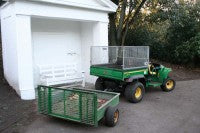 and soil conditioning. The investment of a chemical tank-mixing unit also improved the capabilities of our feeding regimes."
and soil conditioning. The investment of a chemical tank-mixing unit also improved the capabilities of our feeding regimes."
"Liquid feeding is proving to be more cost effective, and more responsive, with good results being noted in colour and growth and health of the sward." "We also invested in an Allett Big John tractor mounted deep scarifier which has speeded up the process of scarifiying the courts and lawns."
Peter has also been improving the sward quality of the tennis courts and has gradually changed the composition from fescue/bent into a predominantly pure perennial rye sward, each and every year sowing a new blend of pure rye grasses, along with increasing the frequency of mowing and cultural operations to improve sward density.
Croquet lawns 7, 8, 9 and 10 are part of the cricket outfield. They are open for play every day between September and March and for corporate hire and tournament use during the summer, while lawns 1-4 are prepared for the summer months. The grass tennis courts are opened in May and close for refurbishment at the end of September.
Similarly, the cricket facilities are used between April and September with the square cut to 12mm in the summer, rising to 15mm in the winter. They are subject to a typical ten day preparation programme and each strip is used at least twice to accommodate the heavy fixture list.
The croquet lawns and bowling greens are cut to 4mm and, occasionally, reduced to 3.5mm for tournaments. Winter height is 6mm. There is also a small, nine hole, pitch and putt golf course available through the winter months. Greens are maintained at 5mm. The golfers play from artificial tee mats which are brought in and stored through the summer.
 The tennis courts used to be cut as low as 6mm during the playing season but, thanks to the new loam and working practices, they are now cut between 8-9mm and, in winter, 12-14mm. This has greatly improved the quality and strength of the sward.
The tennis courts used to be cut as low as 6mm during the playing season but, thanks to the new loam and working practices, they are now cut between 8-9mm and, in winter, 12-14mm. This has greatly improved the quality and strength of the sward.
Last June Peter encountered a serious problem on the match grass courts in the form of yellowing and dying grass in positions exactly where the old lines used to be marked out.
"We had to reseed a lot of the areas and they have still not fully recovered" said Peter. "So, to try and identify the problem, we had a soil analysis carried out and it seems, from the results, almost certain that arsenic in the soil is to blame!"
"The minimum safe level for arsenic is <40 and our reading was 84.57. My theory is that, for many years, lime was used as the marking material. To prevent the obvious worm infestation that this would cause, the groundsmen put a touch of arsenic in with his marking mix to subdue them as, back then, it was commonly used as a worm killer."
After some detective work, and reading an article taken from a 1948 edition of the Groundsman magazine, written by then Hurlingham Head Groundsman of fifty years, Tom Grey, Peter's theory appears to be backed up; "Worms must be removed from the courts; I use Lead-Arsenate. 15lbs L/A mixed with about 100lbs sifted compost covers 300 square yards, this also acts as a good leather jacket destroyer; this dressing lasts for about three years and is put on during November or December."
"I am now going to investigate the problem further and, if necessary, will have to remove any contaminated soils" said Peter. "If we have to take that route, which to be honest seems unlikely, it will add to our workload considerably."
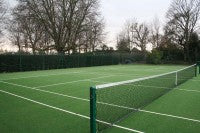 "We inspect the playing surfaces daily for any wear during the playing season. It is important any wear on the tennis court base lines and in the croquet hoop runs is kept to a minimum. As soon as there is any sign of wear we move play to other courts or the hoops are moved to prevent further wear."
"We inspect the playing surfaces daily for any wear during the playing season. It is important any wear on the tennis court base lines and in the croquet hoop runs is kept to a minimum. As soon as there is any sign of wear we move play to other courts or the hoops are moved to prevent further wear."
"The artificial tennis courts are also inspected daily and brushed weekly to remove surface debris, particularly the fourteen sand filled carpet courts, which also get further specialised treatments and sand replacement. Due to the excessively high usage, the life span of the each court is around seven years so, on a rolling programme, I aim to replace the carpet on two courts every seven years."
"For any specialist works, tree surgery, tractor mounted spraying, court cleaning, major end of season renovations, koroing etc., I will call in specialist contractors."
Staff training is ongoing. "I have set up an in-house training programme that provides over one hundred key skills training activities across all areas" said Peter. "Whilst they tend to be very basic, essential activities, I do need to ensure that the staff maintain the excellent standards of horticulture and groundsmanship expected at Hurlingham." (An example, in this instance, cricket, is shown here.)
 Other training will involve external qualifications, gaining PA1 PA6 spraying qualifications and any other relevant required certificates.
Other training will involve external qualifications, gaining PA1 PA6 spraying qualifications and any other relevant required certificates.
Peter also employs the services of two consultants, David Whittaker (sportsturf) and Lucy Huntington (gardens), to advise on the grounds.
Lucy helps Mike design new planting plans, whilst David keeps an eye on the performance of the sports facilities.
Peter works very closely with his line managers and is very responsive to members' requests and ideas, which tend to be channelled through the landscape working party group who meet regularly.
The grounds are also a wonderful haven for wildlife, especially the two acre lake which provides a sanctuary for many birds and animals. Mike and Helen are keen environmentalists and regularly feed the birds and provide nesting boxes. The club also has its own flock of peacocks that roam the grounds.
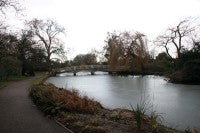 One of the last jobs to be undertaken before this year's busy playing season gets underway is the dredging of the lake, a major project that Peter has initiated. It will be dredged to remove more than 15,000 cubic metre of material that will be taken off site.
One of the last jobs to be undertaken before this year's busy playing season gets underway is the dredging of the lake, a major project that Peter has initiated. It will be dredged to remove more than 15,000 cubic metre of material that will be taken off site.
With over 14,000 members to cater for at the Hurlingham Club it is hardly surprising that Peter and his staff are kept busy throughout the year.
It really is a unique place and the challenges it throws up to those who have to manage it are equally unique.
Peter appears to thoroughly enjoy his job and talks enthusiastically about all aspects of his work. He never underestimates how important the skill and endeavour of his team are in providing the outstanding facilities at one of the best kept secrets in West London.
